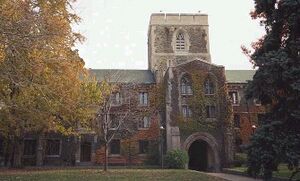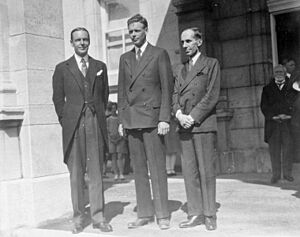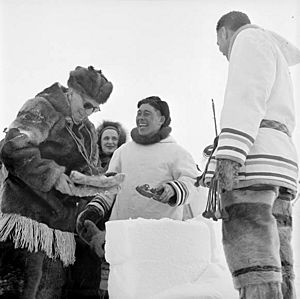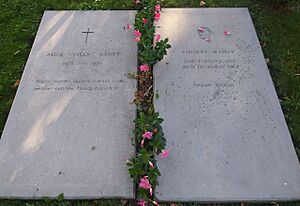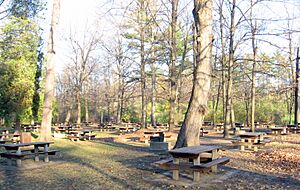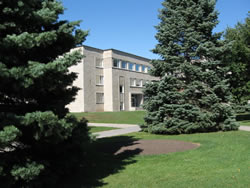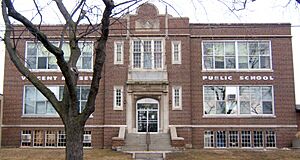Vincent Massey facts for kids
Quick facts for kids
Vincent Massey
|
|
|---|---|
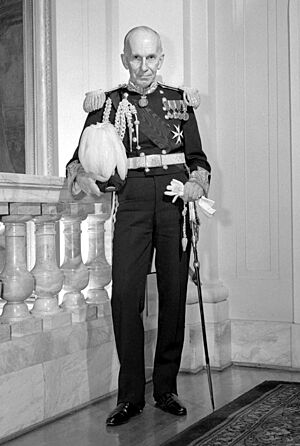
Massey, c. 1956
|
|
| 18th Governor General of Canada | |
| In office February 28, 1952 – September 15, 1959 |
|
| Monarch | Elizabeth II |
| Prime Minister | Louis St. Laurent John Diefenbaker |
| Preceded by | The Viscount Alexander of Tunis |
| Succeeded by | Georges Vanier |
| 7th High Commissioner of Canada to the United Kingdom | |
| In office 1935–1946 |
|
| Prime Minister | William Lyon Mackenzie King |
| Preceded by | Howard Ferguson |
| Succeeded by | Norman Robertson |
| 1st Envoy Extraordinary of Canada to the United States | |
| In office November 25, 1926 – July 23, 1930 |
|
| Prime Minister | William Lyon Mackenzie King |
| Preceded by | Position established |
| Succeeded by | William Duncan Herridge |
| Personal details | |
| Born |
Charles Vincent Massey
February 20, 1887 Toronto, Ontario, Canada |
| Died | December 30, 1967 (aged 80) London, England |
| Spouse |
Alice Massey
(m. 1915; died 1950) |
| Children | Lionel Massey Hart Parkin Vincent Massey II |
| Relatives | Raymond Massey (brother) Daniel Massey (nephew) Anna Massey (niece) |
| Alma mater | University College, Toronto Balliol College, Oxford |
| Profession | Diplomat |
| Signature | |
| Military service | |
| Allegiance | Non-Permanent Active Militia |
| Years of service | 1907 - 1915 |
| Rank | Lieutenant Captain |
| Unit | Queen's Own Rifles (1907-14) University of Toronto Officer Corps (1915) |
| Battles/wars | First World War |
Charles Vincent Massey (February 20, 1887 – December 30, 1967) was a Canadian diplomat and politician. He made history by becoming the 18th Governor General of Canada and the first one born in Canada. This was a big step for Canada, showing its growing independence.
Massey came from a wealthy and influential family in Toronto. He studied in Ontario and England, where he became friends with William Lyon Mackenzie King, who later became a prime minister. After serving in the military during the First World War, Massey started his career as a diplomat. He represented Canada in the United States and the United Kingdom. When he returned to Canada in 1946, he led an important study on arts and culture. This study, known as the Massey Report, led to the creation of institutions like the National Library of Canada and the Canada Council for the Arts. In 1952, King George VI appointed him Governor General, a role he held until 1959.
After his time as Governor General, Massey continued to support education and the arts. He founded Massey College at the University of Toronto and the Massey Lectures. He passed away on December 30, 1967.
Contents
Early Life and Education
Vincent Massey was born in Toronto, Ontario. His parents were Anna (née Vincent) and Chester Daniel Massey. His father owned the Massey-Harris Co., which later became Massey Ferguson. The Massey family was one of the richest in Toronto. His brother was the famous Canadian-American actor Raymond Massey. The Massey family originally came from England and settled in North America in the 1600s. They were strong Methodists and supported many religious, cultural, and educational groups. These included Victoria University, Massey Hall, and the Metropolitan United Church.
Massey grew up in a large family home on Jarvis Street. He went to St. Andrew's College from 1902 to 1906. Then he attended University College at the University of Toronto. In 1907, he joined The Queen's Own Rifles of Canada. He also joined the Kappa Alpha Society, where he met his long-time friend, William Lyon Mackenzie King. After getting his Bachelor of Arts degree in history and English, Massey continued his studies at Balliol College at the University of Oxford. He earned a Master of Arts degree in history there.
In 1911, Massey noticed that the University of Toronto needed a place for students to do extracurricular activities. He donated money to build a student center, which later became Hart House. In 1913, he returned to Toronto and became the first Dean of Men at Burwash Hall. This building was a residence at Victoria University, donated by his father. He also taught modern history at the college. When Canada joined the First World War in 1914, Massey became an officer. He worked for the Cabinet war committee. On June 4, 1915, Massey married Alice Parkin. They had two sons, Lionel Massey and Hart Parkin Vincent Massey II. Massey left the military when the war ended in 1918.
In 1921, Massey became the president of his father's company, Massey-Harris Co. He also pursued his interest in arts and education. He started the Massey Foundation in 1918 to collect paintings and sculptures. By 1922, the student center at the University of Toronto was finished. It was named Hart House in memory of Massey's grandfather. Massey enjoyed acting and directing plays in the theatre there.
Political and Diplomatic Career
In 1925, Massey decided that corporate life was not for him and resigned from Massey-Harris. On September 16, he was appointed to the King's Privy Council and became a minister without portfolio in Mackenzie King's government. He ran for a seat in the House of Commons but was not elected. Even though he left his cabinet job, Massey was part of the Canadian team at the 1926 Imperial Conference. This conference led to important changes in the role of the monarch and their representatives in the British Empire.
In 1932, Massey became the first president of the new National Liberal Federation of Canada. This organization helped to unite the Liberal Party. In the 1935 federal election, the Liberals won, and Mackenzie King became prime minister again. Massey managed the Liberal campaign. He tried to show Mackenzie King as a steady and experienced leader who could handle the Great Depression. Massey even created the slogan "It's either King or Chaos!"
Massey would have preferred to return to politics, but he accepted a diplomatic role instead. He believed that Canada was a British nation in North America with a French influence. He thought being Canadian meant blending British traditions with North American life. His love for British culture made him try to act like an "English gentleman," which some people found snobby.
Envoy to the United States
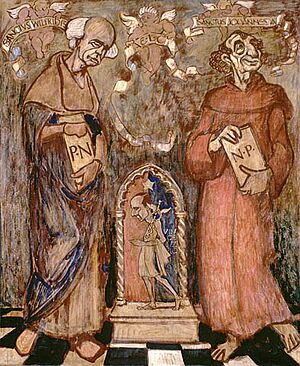
On November 25, 1926, Massey was appointed as Canada's first Envoy Extraordinary and Minister Plenipotentiary to the United States. This made him Canada's first diplomat with full credentials in a foreign capital. He returned to Canada in 1930. Mackenzie King wanted him to be the High Commissioner to the United Kingdom. However, the Liberal Party lost the election, and Richard Bennett became prime minister. Bennett did not want Massey as the representative to the UK because Massey had been a Liberal Cabinet member.
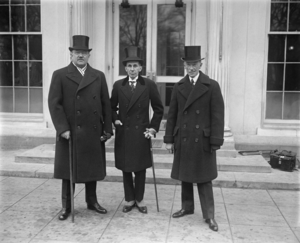
High Commissioner in London
On November 8, 1935, Massey was appointed High Commissioner to the United Kingdom. He arrived at Canada House and found Georges Vanier, who would later become his successor as Governor General, working as his secretary. Massey's time in London included important events like the death of King George V and the abdication of King Edward VIII. Massey was a big fan of Britain and had always wanted to be the Canadian high commissioner in London.
During the abdication crisis in 1936, Massey supported Prime Minister Stanley Baldwin against King Edward VIII. He agreed that the king, who was also the head of the Church of England, should not marry a divorced American woman. Massey was very honored to take part in the coronation of King George VI in May 1937. He served as one of the royal standard-bearers. Massey had a deep respect for the monarchy.
Starting in May 1936, Massey hosted weekly meetings at his house with all the high commissioners from the British Dominions. They discussed important issues. Massey, along with Stanley Bruce of Australia and Charles te Water of South Africa, were seen as the "big three" because their countries were the most powerful Dominions. Massey was known in London for his aristocratic manner, which some people found snobby.
During the Second World War, Massey worked hard to help Canada's war effort. He also served as a trustee for the National and Tate galleries in London. For his work, King George VI made him a member of the Order of the Companions of Honour in 1946. After Britain declared war in September 1939, the high commissioners formed a "junior war cabinet" to represent their countries' interests to the British government. Massey and Bruce were seen as the leaders of this group.
In September 1939, Massey and Bruce suggested a plan to train airmen in Canada and Australia. This idea led to the creation of the British Commonwealth Air Training Plan. Massey considered this one of his greatest achievements. However, Prime Minister Mackenzie King sometimes undermined Massey, telling the British that Massey did not speak for Canada. Mackenzie King wanted to limit Canada's role in the war, while Massey wanted Canada to do as much as possible to help Britain.
Massey was against Britain being too harsh with Vichy France, believing that Marshal Philippe Pétain had signed the armistice to save his nation. He thought Pétain could be convinced to rejoin the Allies. Massey disliked Charles de Gaulle and his French National Committee. Massey was also against the Destroyers-for-bases deal, where Britain gave the United States naval bases in exchange for old destroyers. He worried that the American bases in Newfoundland would lead to the US taking over the island, which he saw as a future Canadian province.
From 1942 onwards, Massey also represented the Canadian military headquarters in London. He worked closely with military leaders like J. L. Ralston and General Harry Crerar. Massey had a difficult relationship with General Andrew McNaughton, the commander of the 1st Canadian Army.
After returning to Canada, Massey continued his work in culture. He chaired the National Gallery of Canada from 1948 to 1952 and was Chancellor of the University of Toronto from 1948 to 1953. In 1949, he led the Royal Commission on National Development in the Arts, Letters and Sciences. This commission studied the state of Canadian culture. Its 1951 report suggested that the government should fund many cultural activities. This led to the creation of the National Library of Canada and the Canada Council for the Arts.
Canada's First Canadian Governor General
Massey was the first Governor General of Canada who was born in Canada. All the Governors General before him were born in other parts of the British Empire or British Commonwealth. His wife had passed away in 1950, making him the only unmarried person to live at Rideau Hall until 2017. Usually, the Governor General's wife acts as the hostess. During Massey's time, his daughter-in-law, Lilias Massey, took on this role.
Becoming Governor General
On February 1, 1952, the Canadian Prime Minister's Office announced that King George VI had approved Massey as the next Governor General. However, five days later, the King died. So, when Massey was sworn in, he became the first Canadian-born representative of the new Queen, Elizabeth II. There wasn't much celebration around his appointment because of the King's death. Massey was in London at the time and attended the new Queen's Accession Council on February 7.
In Canada, some people had mixed feelings about a Canadian-born Governor General. Traditionalists were unsure about someone who wasn't a British noble. Massey was seen as a good choice because he was Canadian but also represented loyalty and formality. Massey said he looked to a previous Governor General, the Baron Tweedsmuir, for inspiration. He admired him greatly and learned a lot from him.
Life magazine wrote about Massey, describing him as elegant and truly Canadian. Massey believed that the Crown belonged to Canadians. He saw his job as connecting the people with the monarch. He also thought that the arts were important for showing Canada's unique identity and should be available to everyone.
In Office
On February 28, 1952, Massey was sworn in as Governor General in the Senate chamber. He received the Canadian Forces' Decoration. His first few months were quiet due to a period of national mourning for the King. It wasn't until Queen Elizabeth II's coronation on June 2, 1953, that Massey led a national celebration. For this event, he rode in the state carriage from Rideau Hall to Parliament Hill. There, he introduced the Queen's coronation speech, which was broadcast worldwide. He also gave a silver spoon to every child born on that day.
Massey welcomed the Queen and the Duke of Edinburgh to Ottawa three times starting in 1957. When they toured Canada, Massey invited them to stay at his private home, Batterwood. He also hosted leaders from other countries, including United States president Dwight D. Eisenhower in 1953. Eisenhower then invited Massey to Washington, D.C., where Massey spoke to the joint session of the United States Congress in 1954.
Massey wanted to unite Canada's different cultures. He traveled across the country, using canoes and dog sleds, and gave speeches promoting bilingualism. This was about 20 years before it became an official national policy. He opened the new Royal Saskatchewan Museum in 1955. In 1958, his Dominion Day speech launched the Canadian Broadcasting Corporation's first national televised broadcast. Massey also explored the Canadian Arctic, visiting places like Frobisher Bay and Hall Beach. He met with local Inuit people and took part in their activities. During his time as Governor General, Massey also became involved with Upper Canada College, donating money and time to the school.
Massey wanted to create an entirely Canadian honours system. Although it wasn't created during his time, he helped set the stage for the system that his successor would put in place. In 1967, just months before he died, Massey became one of the first members of the Order of Canada.
Promoting Canadian Culture
Many people believe Massey's most important years were between 1949 and 1959. During this time, he greatly helped bring arts and culture to the forefront of national attention. He created awards for artistic achievements, like the Governor General's Medals in Architecture. He also promoted the idea of a national arts festival, which led to the creation of the National Arts Centre. In 1954, Massey started the Governor General's gold medal for the Institute of Chartered Accountants. In 1959, he initiated the Massey Medal for excellence in geography for the Royal Canadian Geographical Society.
Later Life and Death
After leaving Rideau Hall, Massey retired to his home, Batterwood House, near Port Hope, Ontario. For his service to the Crown, Queen Elizabeth II awarded him the Royal Victorian Chain. This made him the first Canadian to receive this special honour. Just before his term ended, the Queen thanked Massey for his work. She praised him for maintaining the right relationship between the Crown and the people of Canada. The Queen wanted to make Massey a Knight of the Order of the Garter, but Prime Minister John Diefenbaker advised against it.
Massey continued his charitable work, especially supporting the University of Toronto through the Massey Foundation. His donation of Hart House to the University of Toronto originally stated that the building was only for men. After his death, this rule was changed in 1972 to allow women to become full members. In 1963, he established Massey College at the University of Toronto. His protégé, Robertson Davies, became the college's first master. In 1961, the Massey Lectures were started. These lectures focus on important current issues and are considered a very important public lecture series in Canada.
Vincent Massey died on December 30, 1967, while on holiday in the United Kingdom. His body was returned to Canada, and he received a state funeral in early January 1968. He was buried next to his wife at St. Mark's Church in Port Hope.
Honours and Recognition
Appointments
 1946 – December 30, 1967: Member of the Order of the Companions of Honour (CH)
1946 – December 30, 1967: Member of the Order of the Companions of Honour (CH) September 16, 1925 – December 30, 1967: Member of the King's Privy Council for Canada (PC)
September 16, 1925 – December 30, 1967: Member of the King's Privy Council for Canada (PC) June 6, 1941 – December 30, 1967: Member of His Majesty's Most Honourable Privy Council
June 6, 1941 – December 30, 1967: Member of His Majesty's Most Honourable Privy Council February 28, 1952 – 1955: Knight of Justice, Prior, and Chief Officer in Canada of the Most Venerable Order of the Hospital of Saint John of Jerusalem (KStJ)
February 28, 1952 – 1955: Knight of Justice, Prior, and Chief Officer in Canada of the Most Venerable Order of the Hospital of Saint John of Jerusalem (KStJ)
- July 1, 1955 – September 15, 1959: Bailiff Grand Cross, Prior, and Chief Officer in Canada of the Most Venerable Order of the Hospital of Saint John of Jerusalem (GCStJ)
- September 15, 1959 – December 30, 1967: Bailiff Grand Cross of the Venerable Order of Saint John (GCStJ)
 February 28, 1952 – September 15, 1959: Chief Scout of Canada
February 28, 1952 – September 15, 1959: Chief Scout of Canada 1952 – December 30, 1967: Honorary Member of the Royal Military College of Canada Club
1952 – December 30, 1967: Honorary Member of the Royal Military College of Canada Club July 9, 1967 – December 30, 1967: Companion of the Order of Canada (CC)
July 9, 1967 – December 30, 1967: Companion of the Order of Canada (CC) Honorary Fellow of the Royal Society of Canada (FRSC(hon))
Honorary Fellow of the Royal Society of Canada (FRSC(hon))
Medals
 1935: King George V Silver Jubilee Medal
1935: King George V Silver Jubilee Medal 1937: King George VI Coronation Medal
1937: King George VI Coronation Medal February 28, 1952: Canadian Forces' Decoration (CD)
February 28, 1952: Canadian Forces' Decoration (CD) 1953: Queen Elizabeth II Coronation Medal
1953: Queen Elizabeth II Coronation Medal 1967: Canadian Centennial Medal
1967: Canadian Centennial Medal
Awards
 July 22, 1960: Royal Victorian Chain
July 22, 1960: Royal Victorian Chain December 11, 1963: Augmentation of honour
December 11, 1963: Augmentation of honour
Honorary Military Appointments
 February 28, 1952 – September 15, 1959: Colonel of the Governor General's Horse Guards
February 28, 1952 – September 15, 1959: Colonel of the Governor General's Horse Guards February 28, 1952 – September 15, 1959: Colonel of the Governor General's Foot Guards
February 28, 1952 – September 15, 1959: Colonel of the Governor General's Foot Guards February 28, 1952 – September 15, 1959: Colonel of the Canadian Grenadier Guards
February 28, 1952 – September 15, 1959: Colonel of the Canadian Grenadier Guards
Honorary Degrees
 1951: Queen's University, Doctor of Laws (LLD)
1951: Queen's University, Doctor of Laws (LLD) May 13, 1955: University of Saskatchewan, Doctor of Laws (LLD)
May 13, 1955: University of Saskatchewan, Doctor of Laws (LLD) May 18, 1954: University of British Columbia, Doctor of Laws (LLD)
May 18, 1954: University of British Columbia, Doctor of Laws (LLD)
Places and Things Named After Vincent Massey
- Geographic Locations
 Alberta: Mount Massey
Alberta: Mount Massey Newfoundland and Labrador: Massey Drive
Newfoundland and Labrador: Massey Drive Ontario: Massey, Ontario
Ontario: Massey, Ontario Ontario: Vincent Massey Park, Ottawa
Ontario: Vincent Massey Park, Ottawa Saskatchewan: Massey Place, Saskatoon
Saskatchewan: Massey Place, Saskatoon Saskatchewan: Massey Park, Saskatoon
Saskatchewan: Massey Park, Saskatoon
- Buildings
 British Columbia: Vincent Massey Theatre (later Massey Theatre), New Westminster
British Columbia: Vincent Massey Theatre (later Massey Theatre), New Westminster Ontario: Massey Building, Royal Military College of Canada, Kingston
Ontario: Massey Building, Royal Military College of Canada, Kingston
- Massey Library, within the Massey Building
 Ontario: Massey Quadrangle, Upper Canada College, Toronto
Ontario: Massey Quadrangle, Upper Canada College, Toronto Ontario: Vincent Massey Memorial Centre, Bewdley
Ontario: Vincent Massey Memorial Centre, Bewdley Ontario: Massey House, Trinity College, Toronto
Ontario: Massey House, Trinity College, Toronto Quebec: Place Vincent Massey, Gatineau
Quebec: Place Vincent Massey, Gatineau Quebec: Massey Building, Collège militaire royal de Saint-Jean, Saint-Jean-sur-Richelieu
Quebec: Massey Building, Collège militaire royal de Saint-Jean, Saint-Jean-sur-Richelieu
- Schools
 Alberta: Vincent Massey Junior High School, Calgary
Alberta: Vincent Massey Junior High School, Calgary Alberta: Vincent Massey School, Medicine Hat
Alberta: Vincent Massey School, Medicine Hat Manitoba: Vincent Massey High School, Brandon
Manitoba: Vincent Massey High School, Brandon Manitoba: Vincent Massey Collegiate, Winnipeg
Manitoba: Vincent Massey Collegiate, Winnipeg New Brunswick: Vincent Massey Elementary School, St. Andrews
New Brunswick: Vincent Massey Elementary School, St. Andrews Ontario: Vincent Massey Public School, Bowmanville
Ontario: Vincent Massey Public School, Bowmanville Ontario: Vincent Massey Public School, Cornwall (closed)
Ontario: Vincent Massey Public School, Cornwall (closed) Ontario: Vincent Massey Collegiate Institute, Etobicoke (closed)
Ontario: Vincent Massey Collegiate Institute, Etobicoke (closed) Ontario: Vincent Massey Public School, Etobicoke
Ontario: Vincent Massey Public School, Etobicoke Ontario: Vincent Massey Public School, Etobicoke (closed)
Ontario: Vincent Massey Public School, Etobicoke (closed) Ontario: Vincent Massey School, Hamilton
Ontario: Vincent Massey School, Hamilton Ontario: Vincent Massey Public School, North Bay
Ontario: Vincent Massey Public School, North Bay Ontario: Vincent Massey Public School, Oshawa
Ontario: Vincent Massey Public School, Oshawa Ontario: Vincent Massey Public School, Ottawa
Ontario: Vincent Massey Public School, Ottawa Ontario: Vincent Massey School, Ottawa
Ontario: Vincent Massey School, Ottawa Ontario: Massey College, University of Toronto, Toronto
Ontario: Massey College, University of Toronto, Toronto Ontario: Vincent Massey Secondary School, Windsor
Ontario: Vincent Massey Secondary School, Windsor Quebec: Vincent Massey Collegiate, Montreal
Quebec: Vincent Massey Collegiate, Montreal Quebec: Vincent Massey Elementary School, Saint-Hubert
Quebec: Vincent Massey Elementary School, Saint-Hubert Quebec: Massey-Vanier High School, Cowansville
Quebec: Massey-Vanier High School, Cowansville Saskatchewan: Vincent Massey Community School, Prince Albert
Saskatchewan: Vincent Massey Community School, Prince Albert Saskatchewan: Ecole Massey School, Regina
Saskatchewan: Ecole Massey School, Regina Saskatchewan: Vincent Massey School, Saskatoon
Saskatchewan: Vincent Massey School, Saskatoon Saskatchewan: Vincent Massey Public School, Saskatoon
Saskatchewan: Vincent Massey Public School, Saskatoon
- Civic Structures
 Ontario: Massey Road, Canton
Ontario: Massey Road, Canton
Coat of Arms
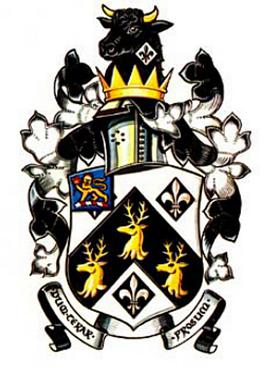 |
|
Electoral Record
| Canadian federal election, 1925: Durham | ||||||||
|---|---|---|---|---|---|---|---|---|
| Party | Candidate | Votes | % | ±%} | ||||
| Conservative | Fred Wellington Bowen | 7,020 | 53.61 | +12.71 | ||||
| Liberal | Charles Vincent Massey | 6,074 | 46.39 | +5.48 | ||||
See Also
- Diplomatic corps
- Massey Foundation


